What if you never had to send outbound emails? Make cold calls? Spend thousands of dollars on ads? Or wait and hope for referrals to get leads?
…Because you had a steady stream of ready-to-purchase, qualified leads, arriving through your blog, month after month?
Achieving that steady stream requires a system, not a collection of random, beginner-level tactics, but a repeatable process and a focused content strategy to attract your ideal customer — even high-end customers such as CEOs.
Over the last few years of running Grow and Convert, this — being able to attract the right kind of traffic, with a high intent to purchase — is the number one request from our readers.
Here are real snippets from emails we’ve received:
“I’m ranking #1 for [specific keywords], etc. but I’m not getting as many subs and sales from those as I think I could be getting.”
“My No. 1 problem or pain is identifying and hitting my ideal target audience with the intention to buy my products and services.”
“I currently have a client I am writing for who is gaining traffic to their blog, but the traffic isn’t converting.”
“Right now my biggest challenge is how to use content marketing to reach high level executives“
The solution to these problems is not tactical. It’s not about installing some popup or nurture sequence that will magically turn unqualified traffic to customers (it won’t). It requires multiple moving pieces coming together as a coherent, repeatable process, namely for:
- Narrowing down to find your best customers
- Identifying their pain points
- Turning those pain points into content ideas
- Producing high quality content that impresses them
- Promoting that content
- Measuring conversions so you know what’s working.
Over the last four years of Grow and Convert, we’ve built such a process. We’ve used it to grow our own business from a fresh WordPress install to a thriving agency, and we’ve used it on dozens of clients.
We’ll share that story and graphs of results below, but first, we want to share a story of early struggles before this process was in place.
Devesh’s Story of Struggling With Content Marketing
Before I met Benji and we started Grow and Convert, I had my AB testing agency, Growth Rock, for years. We had (and still have!) a great service that really added value to clients (seven- and eight-figure ecommerce companies), but leads were hard to come by.
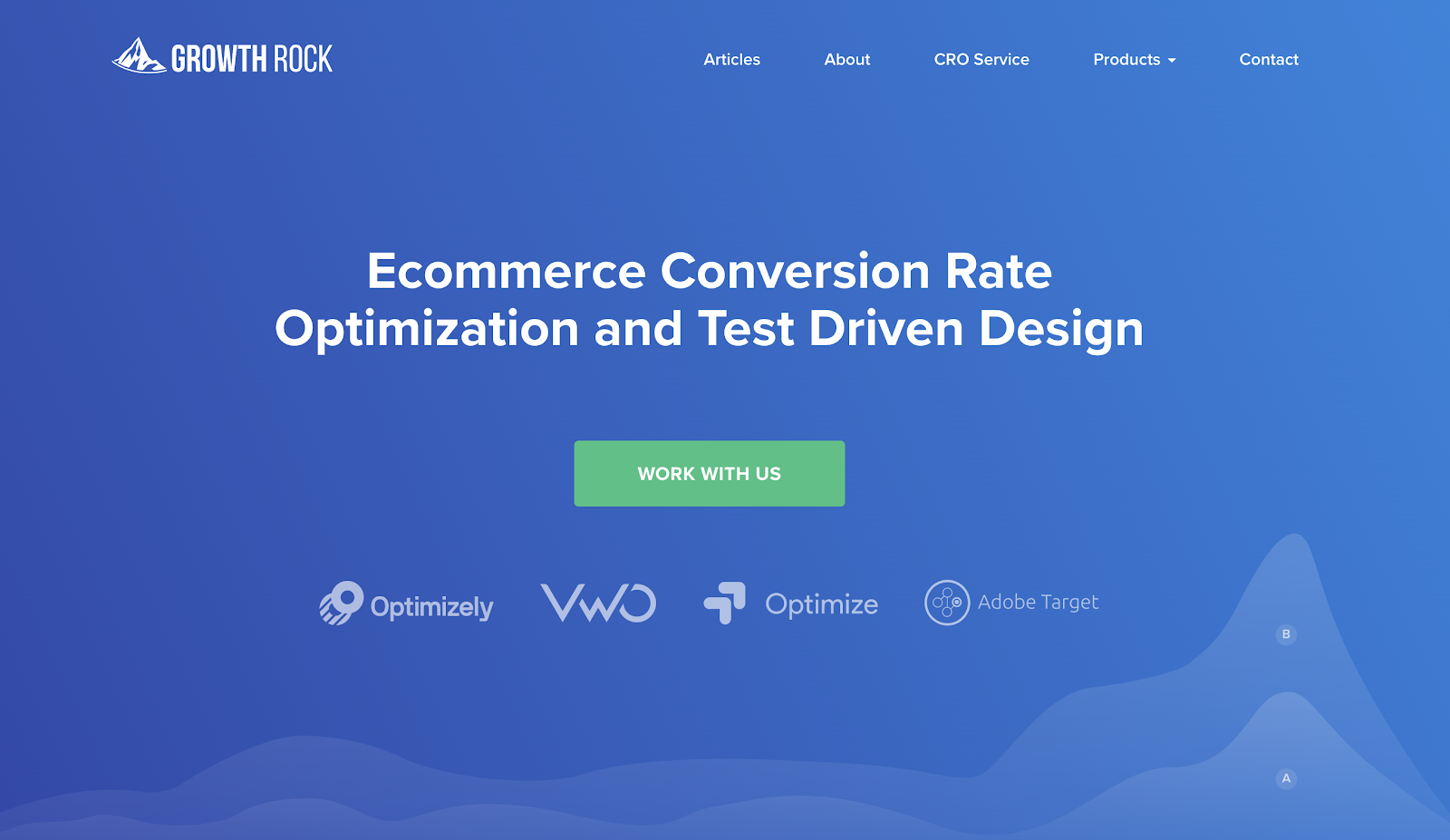
I struggled with getting leads from content for years.
Almost all of my business came from word of mouth and referrals, with the rest coming from some cold emails I sent. I lived through the stereotypical “feast or famine” life of a consultant or small agency:
Get a bunch of clients > Don’t focus on sales/marketing > Lose clients > Focus on sales/marketing > Repeat
I had a blog and dreamt of it building my brand, building a thriving list of high powered ecommerce executives, getting leads, and building some notoriety in the industry. But it, sadly, did none of that.
When I met Benji for the first time ever, at a marketing networking dinner, I told him point blank, “Oh, content doesn’t work for me; I’m trying to target high-end B2B customers. It doesn’t bring those kinds of customers in.”
He said to my face, “That means you don’t know what you’re doing.”
What a great way to meet your business partner. 🙂
But looking back, his comment brings up an important question: What was I doing?
Here’s what…
My #1 Mistake: I Was Writing on Random Topics as They Came to Me
One day I would get into a discussion about email drip campaigns and write a post on it:

Then, I’d get a new idea, like this one I called “product bonuses” and write a post on that:

Then I’d sprinkle in some client case studies (some early signs of kind of knowing what I was doing), before moving back to my next random idea, like a data post on social media statistics:

These posts got engagement — just look at those comment counts!
But they generated almost zero real business. No leads; no sales; nothing. The first sale I got from this blog took years, and it was a short landing page optimization project. I was so excited. But after that small project ended, it was back to nothing.
The Long List of Other Tactics I Tried or Stressed Over
My lack of success with the blog wasn’t for lack of trying. I tried a ton of things:
- I tried different topics: Like I mentioned above, I tried a bunch of different post topics; nothing really worked.
- I tried gated content: I made ebooks and used content upgrades to build an email list. I did build a small, engaged list (1000 people), and that’s why you see the high comment counts above, but it didn’t turn into leads and sales, which is what I wanted so badly.
- I read tactics on blog after blog: Learning from others makes sense; we still do it, but in hindsight, I was following people that had totally different businesses from me. I was trying to sell high-priced B2B services, and I was reading folks selling online courses or a SaaS product. I didn’t know what other agency owners were doing. Did they get leads from content successfully? If so, how?
- I tried long posts; I tried short posts: It didn’t matter; results were the same.
- I tried promoting in online groups: I tried LinkedIn. I tried Reddit. I tried Facebook Groups. I had no consistent way to drive traffic.
- I picked keywords but had no idea how to rank: I used short URLs and started my title with the keywords. Didn’t matter. I didn’t rank.
This is why I was tired of content marketing and told Benji (honestly) that I felt it wasn’t for me. I genuinely thought it just didn’t work.
This is because I didn’t know what I was doing wrong. If I knew, I could have fixed it. But I didn’t know. Was it the content? Was it a conversion funnel? Was it promotion? Was it SEO (or lack thereof)? What actually works? In particular, what works that I could actually execute on, as opposed to just producing 100 posts a month and playing the high volume game? I couldn’t do that; I didn’t have a huge content team.
But it turns out, all these tactics I was stressing over don’t matter:
- It doesn’t matter when you publish
- It doesn’t matter if your posts are long or short
- It doesn’t matter whether you have fancy ebooks.
The only thing that matters is that you have a strategy (not random tactics) that repeatedly gets your idea customer to your content.
Finding a Repeatable System After Starting Grow and Convert
Now, at Grow and Convert, we have a system exactly like what I wanted. We get consistent prospects to our site, and leads hit our inbox week after week, including from well known brands:

Our close rate on leads consistently hovers between 12% – 15%, which has let us grow this to an agency to $1 million ARR+ (annual recurring revenue) with multiple employees, and a fully remote team that we love working with.
We’ve been honored to work with companies from a variety of industries all over the world including big names in their niches like Patreon, Crazy Egg, and ServiceTitan.
And the only marketing channel we’ve ever used is content. We don’t run Google ads. We don’t sponsor newsletters. We don’t cold call. We don’t do events. We just produce content and promote it.
This has not required a herculean effort, either. We don’t publish a ton. You can scroll through our posts and see how infrequently we’ve posted for many stretches, such as this one:![]()
![]()
 One post every 2-3 months! (We don’t recommend publishing this infrequently, but the point is, if you get a content marketing flywheel going, it gets results even when you don’t have time to publish for a while.)
One post every 2-3 months! (We don’t recommend publishing this infrequently, but the point is, if you get a content marketing flywheel going, it gets results even when you don’t have time to publish for a while.)
The way we’ve done this is not magic; it’s strategy. What we write about (content strategy) is very specific, very detailed, and it targets a very specific persona. (You should know this if you’re reading these words).
The Results We’ve Achieved for Clients
But we are just one business. What gives me the most confidence in our content marketing system is not that we’ve grown our own business with it but that we’ve done it for so many other businesses. Here’s a sample across a few different business types.
A Self-Serve B2B SaaS Business
We worked with a company called Leadfeeder for two years and published a long case study on them on our blog. Here are some of the highlights of results we’ve achieved. First, here you can see just the traffic to the blog posts we wrote for them:
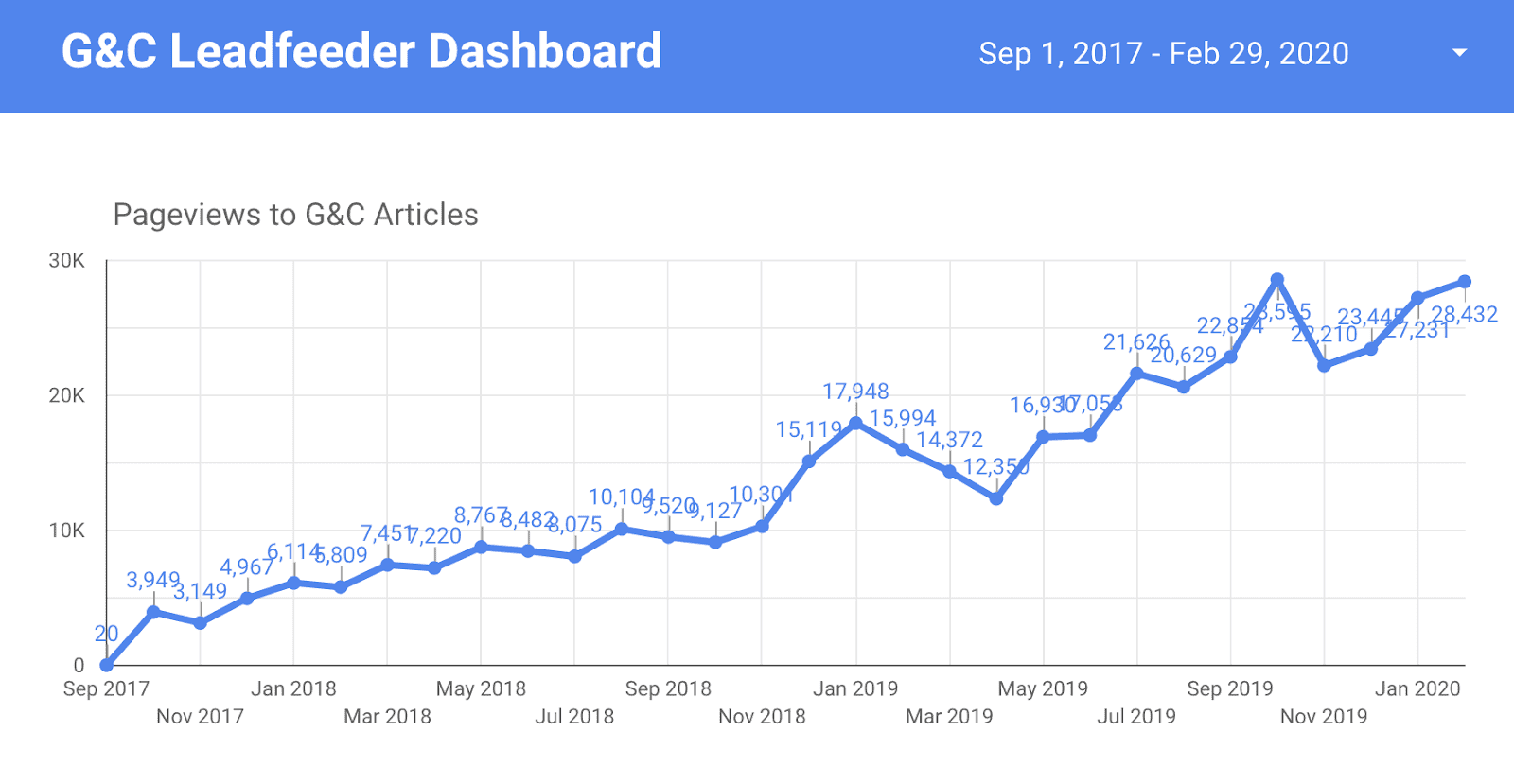 But more importantly, here are signups attributable to our content (first or last click):
But more importantly, here are signups attributable to our content (first or last click):

Look at that steady growth in signups month over month. These signups are primarily from organic search, where the searchers are Googling keywords that we feel indicates serious intent for the app. That is targeted traffic.
In this case, we got permission from Leadfeeder to publish a full case study on the strategy we used for them here.
A High-Touch B2B Service
In contrast, let’s look at very different results for a very different business: a high-priced, long sales process B2B service (a high-end marketing agency). Their pilot projects are $25,000+, and monthly engagements are routinely $10,000+.
In this case, we quickly got to 6,000+ pageviews from a handful of blog posts, and growth from there has been much slower than the self-serve SaaS example above. But that’s intentional. Our content strategy for them is less about keywords and search volume and more about really specific advanced topics that attract and wow their prospects, which gets them to sign up for an intro sales call.
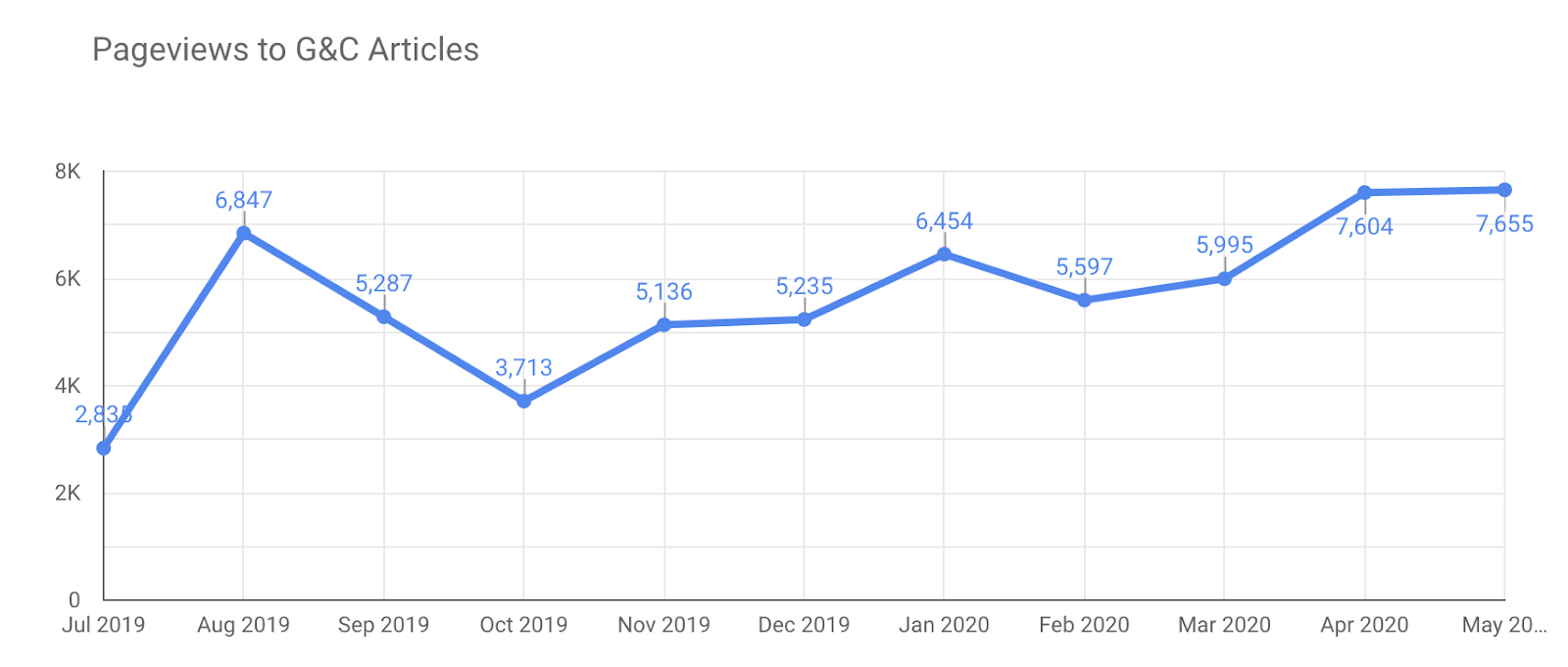
Why is that? Because they are going after advanced companies with budgets that can afford them. Ranking for beginner terms like “seo tips,” which have search volume, is not going to cut it. So we adjusted the strategy for this business to remain focused on what would get the most leads and sales, not vanity traffic.
To measure that, we look in their Hubspot monthly to see how much closed deals and sales qualified leads (“pipeline”) were influenced by our articles. On that front, we see awesome growth:

To get growth like the yellow line is not easy. Randomly publishing blog posts on topics as they come to mind won’t do it. You need to have an intentional system that you execute.
This is also what we mean when we say: The strategy that gets results is different for different businesses. Trying to use the tactics that produced Leadfeeder’s results above on a business like this wouldn’t work well. You need to know the strategy that works for your business type (more on that below)
A B2C In-Person HealthCare Business
As a final example, let’s look at Cognitive FX, a cutting edge, world-leading concussion treatment center and one of our clients. People travel from all over the world to get concussion syndrome treatment at their center in Provo, UT.
In this case they are going after consumers, and their consumers do Google to read up on their symptoms, their child’s symptoms, and their treatment options. So there are many search terms in their space (“concussion syndrome,” “concussion treatment,” etc.), and organic traffic has been a big source of growth for our work with them:
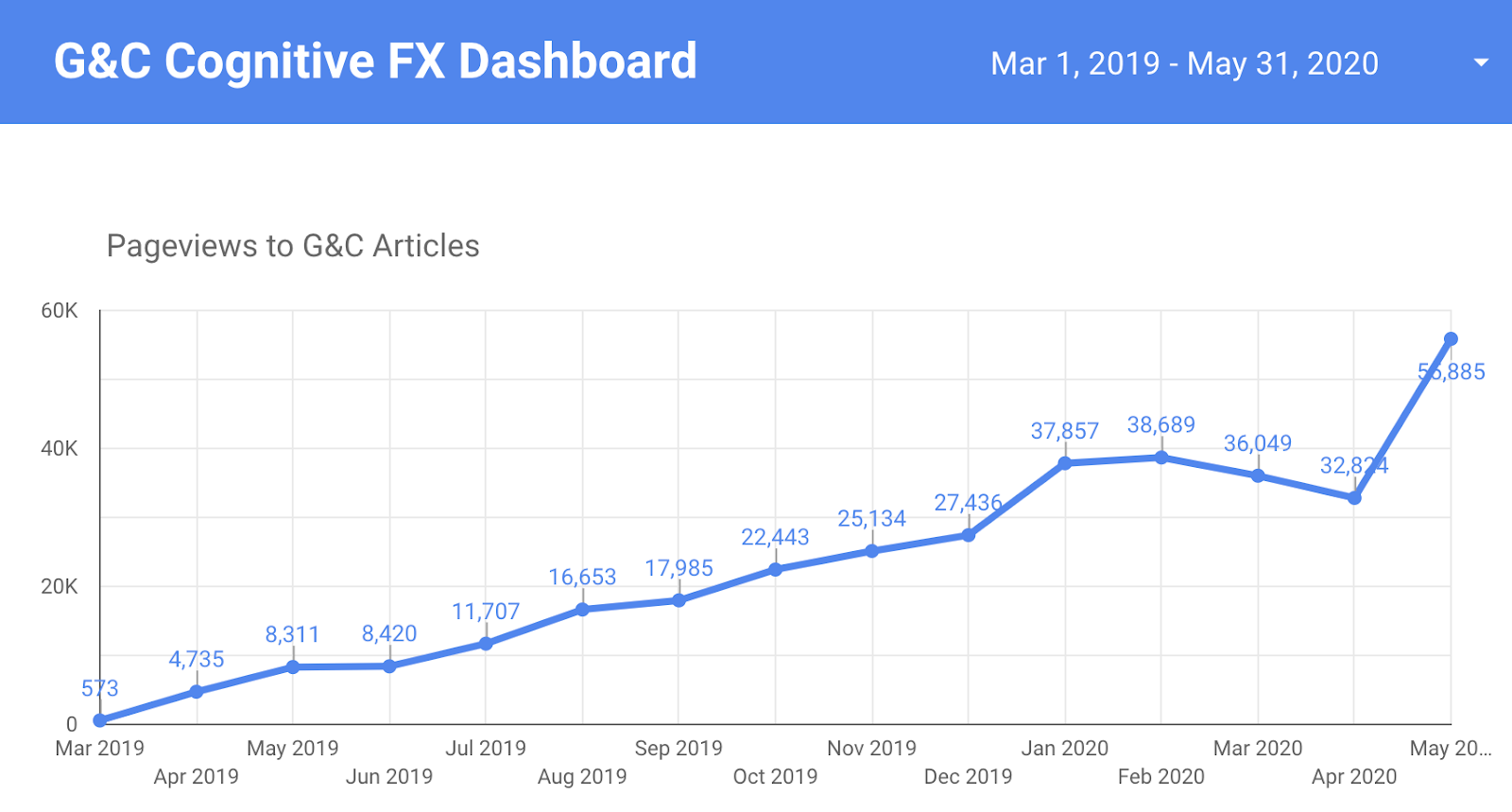
And this traffic is qualified. Leads from our content have grown steadily throughout our engagement:

Sharing This System With More Than Just Our Clients
Above are just three examples, but we’ve done this for dozens of clients over the years — specifically across three business types:
- SaaS businesses
- Service businesses
- B2C businesses.
But our agency is not for everyone, and we have a community of marketers, founders, consultants, and entrepreneurs on our email list that read our blog posts, ask us questions over email, and want to learn these strategies and apply them — but for whom it doesn’t make sense to hire our agency.
So we wanted to create a place — a community — where all of us can (1) learn these processes in a detailed systematic way and (2) discuss the details, share our wins, and help each other.
That is our Grow and Convert Members course and community.
Introducing the Grow and Convert Members Course and Community
Grow and Convert Members (G&C Members) is our private community that has two parts:
- A Detailed Content Marketing Course that teaches our content marketing process
- A Private Community of like-minded, smart marketers, founders, agency owners and entrepreneurs that discuss and share strategies, and where we (Benji and Devesh) do live video Q&As with members and special guests.
Let’s discuss each in turn, starting with the G&C Content Marketing Course.
Our content marketing course is a complete system for running content marketing for almost any business, including content strategy, writing, promoting, and converting traffic from content.
With it, you will, like us, be able to walk into any company and know:
- What they’re doing wrong
- How they should shift their strategy
- What opportunities are untapped
- The role SEO should play and what keywords are relevant
- What topics will bring in the right, qualified visitors
- How to drive thousands of visitors to the content
- How to measure conversions.
Step 1: Strategy: Most Marketers Pick Topics Haphazardly; You Will Know Which Topics Bring Ready-to-Buy Customers
Like we said above, so many of our readers have told us the number one thing they want to learn is how to get conversions from content: Get actual customers, get qualified traffic, get leads, get sales, get conversions.
The problem is, most people think conversions is something you improve with:
- A/B testing
- Popups
- CTAs
- Lead magnets
- Email drip sequences.
It’s not.
The number one factor to getting conversions from content is picking the right topic. If the topic itself brings in traffic that already wants your product or service, it doesn’t really matter what your call-to-action (CTA) is; they will convert.
For example, if you sell accounting software, and your content brings in people who actually want accounting software, you don’t need to stress about your CTA.
Look at this analytics screenshot for two posts for one of our clients:

The top article got ten times the traffic of the bottom, but the bottom one yielded 125% of the top’s signups! How is that possible? By picking the right topic.
We call this content strategy. It is the skill of picking topics and keywords that actually bring in ready-to-buy customers (aka “qualified traffic”).
It is the foundation of our system. If you do this right, then regardless of whether or not you’re a “good writer,” regardless of what CTAs you use (or don’t use), regardless of blog design, regardless of link building or Facebook promotion, it is very, very likely you’ll get conversions from your content.
So, Module 1 of our course is dedicated to it.

But, as we showed above in the example results, a key observation from our agency work is that content strategy differs by business type.
We’ve seen that SaaS companies benefit from one strategy that may not work for Service businesses or B2C businesses.
Our Course Is Case-Study Based so Can You Learn the Strategies That Work for Your Business Type
So to solve this problem, we’ve made the course case-study based.
We case study three businesses, one from each of the above types:
- (B2B SaaS) Liverecover.com: An abandoned-cart software solution for ecommerce companies.
- (B2B Service) Tryolabs.com: A machine-learning-focused development agency targeting enterprise clients.
- (B2C Marketplace) GrowthMentor.com: A marketplace for people looking to find mentors to help them in their career.

In each case study, you get to watch us execute the exact process we use with our real clients, via written explanations and recorded videos.
For example, you’ll see a one-hour user research call with each company’s founders or management teams, split into sections that teach different aspects of what we’re looking for and why:

You then get access to the ideation spreadsheet Benji and I came up with after the ideation call for each of these three companies:
![]()
Then you can watch Benji and me go over the keyword spreadsheet in detail, explaining each group of ideas, and:
- How we came up with it
- How it originated from the user research call above
- Why we think it would convert
- Or if it’s for a non-conversion purpose, what that is
- Which ones we would prioritize
- An example of an initial mix of topics you could start with.

Then, to further help, we even included additional tactical walkthroughs of deeper dives into a few of the ideas and how you can use tools like Ahrefs, Clearscope, or even just Google Suggested Search to come up with these ideas. For example:
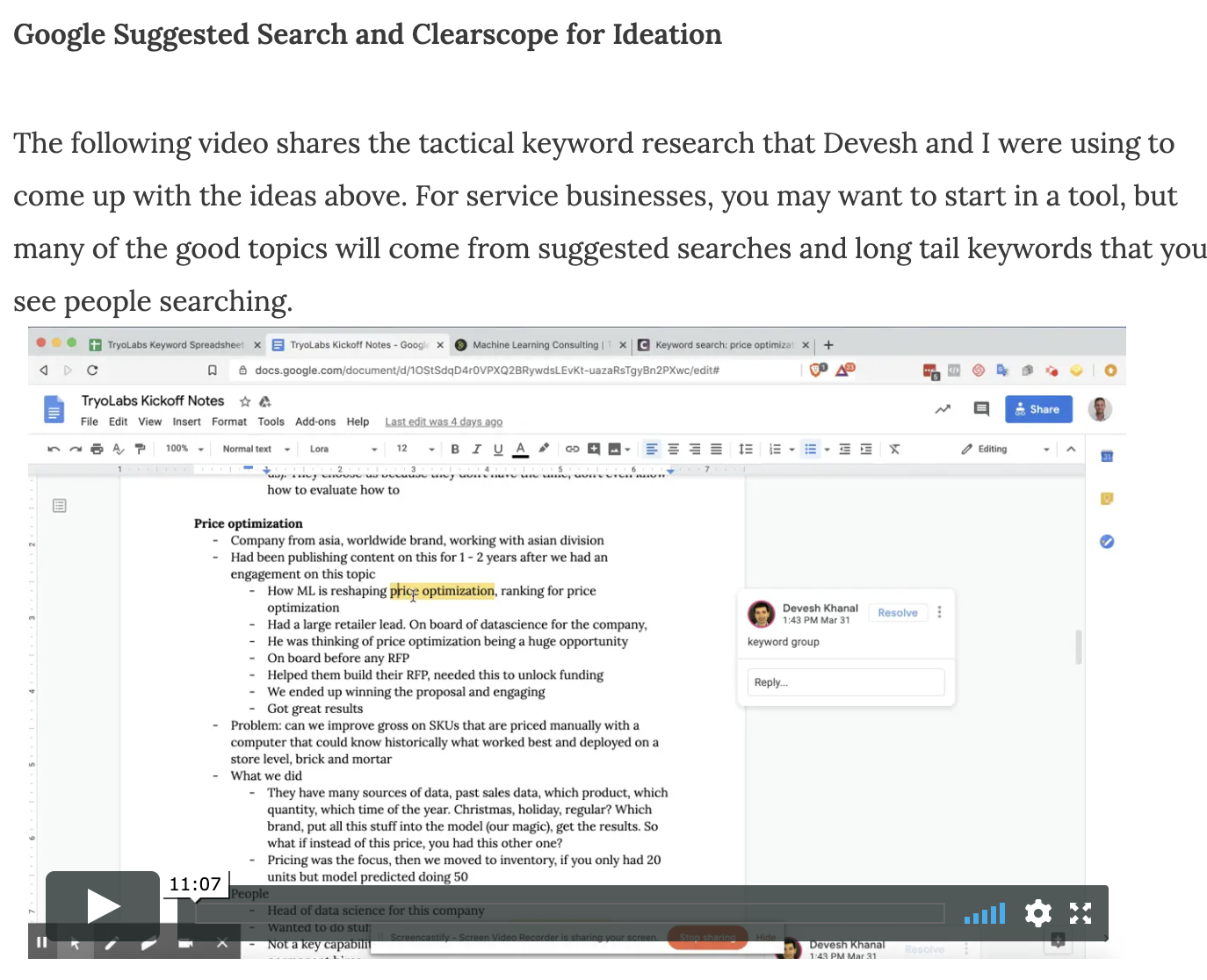
We have not come across another resource like this that teaches content strategy in a step by step way, using multiple differing business types as case studies.
To recap, in Module 1, you will learn:
- How to come up with high-converting topics and keywords by literally watching us do it for three different businesses (from SaaS to Service to a B2C marketplace)
- How we come up with the pain points and content topics via customer research interviews with the management team, including what questions we ask, how we dig for more information, and how it relates to the final content ideas we come up with
- The tools we use to find Pain Point SEO keyword opportunities.
Step 2: Writing: Most Content Is Beginner-Level Fluff; You’ll Learn How to Produce High-End Content That Will Impress Savvy Customers
Almost all content marketing and SEO advice says that “good” content is essential.
But what is “good”? How do you produce “good”? Or how do you get better?
On this topic, the typical advice online is really lacking.
First, most advice is horribly beginner level. Here is an actual “five-step process” to write a blog post from the top result of “how to write a good blog post.” It’s from Wordstream, the well-known digital ad software company (yes, I’m naming names here; it’s necessary):

For us, and our readers, we don’t need to be told that writing a blog post can be done “in a single session or gradually work on parts of it.” Or that you need to “craft a headline” or “use images to enhance your post.”
This is all hopelessly obvious advice. It’s not helping us produce better content.
Second, most advice on writing “good” content is one size fits all. It takes one attribute that applies sometimes and universalizes it to any scenario.
For example, it became really popular in the last few years to equate length with quality. Everyone started producing longer and longer content:
- The Ultimate Guide!
- This epic post!
- Eight thousand words!
When talking to our readers about writing posts, they’re concerns are way more advanced. No one needs instructions on how to publish a blog post or what steps are involved. Our readers aren’t even looking for a specific word count to hit. They know that doesn’t matter.
What everyone wants to know is: How do I write a good blog post that impresses my specific customer?
When we dug into this question, what our readers and members have said is:
My target audience is advanced or niche — they are CEOs, or founders, or heads of departments or industry veterans that I’m selling software or services to — so I can’t publish beginner level content. It needs to be advanced so they actually learn something or are impressed.
Two Key Learnings About Writing Impressive Blog Posts for Specific Customers
Here’s what we’ve learned about writing to a specific customer, who is often advanced in their own knowledge of your field:
First, the knowledge level in your post needs to be above theirs. You can’t produce what we mockingly call a “Google Research Paper,” where you Google around on a topic and regurgitate some stats. You need a better method.
Second, different blog posts need dramatically different things. A customer case study has a completely different writing style required versus a bottom-of-funnel SEO post meant to rank for “top sales software tools.”
We cover how to solve these problems at length in Module 2:

Specifically:
1. Writing at the correct knowledge level. How to avoid writing below your customers’ knowledge level:

With multiple teardowns and comparison videos where we contrast different posts in detail, often line by line, comparing sentences, setups, intros, body, and more.

2. When to use interviews vs. when to write posts yourself.
The majority of blog posts from companies miss the mark because freelance writers with no domain expertise are tasked with writing a post by themselves meant to impress a target customer that knows more than the writer.
That is a broken process.
Our agency has solved this problem by using simple interviews with experts that are — 99% of the time — conducted within our client’s company itself.
In this lesson. we discuss how and why we do this at length:

And how you can do the same thing whether you are part of an in-house team or an outside consultant.
We walk through the ideation spreadsheets of our three case studies companies and talk through what we would do for each type of post, whether we would use an interview, and why:
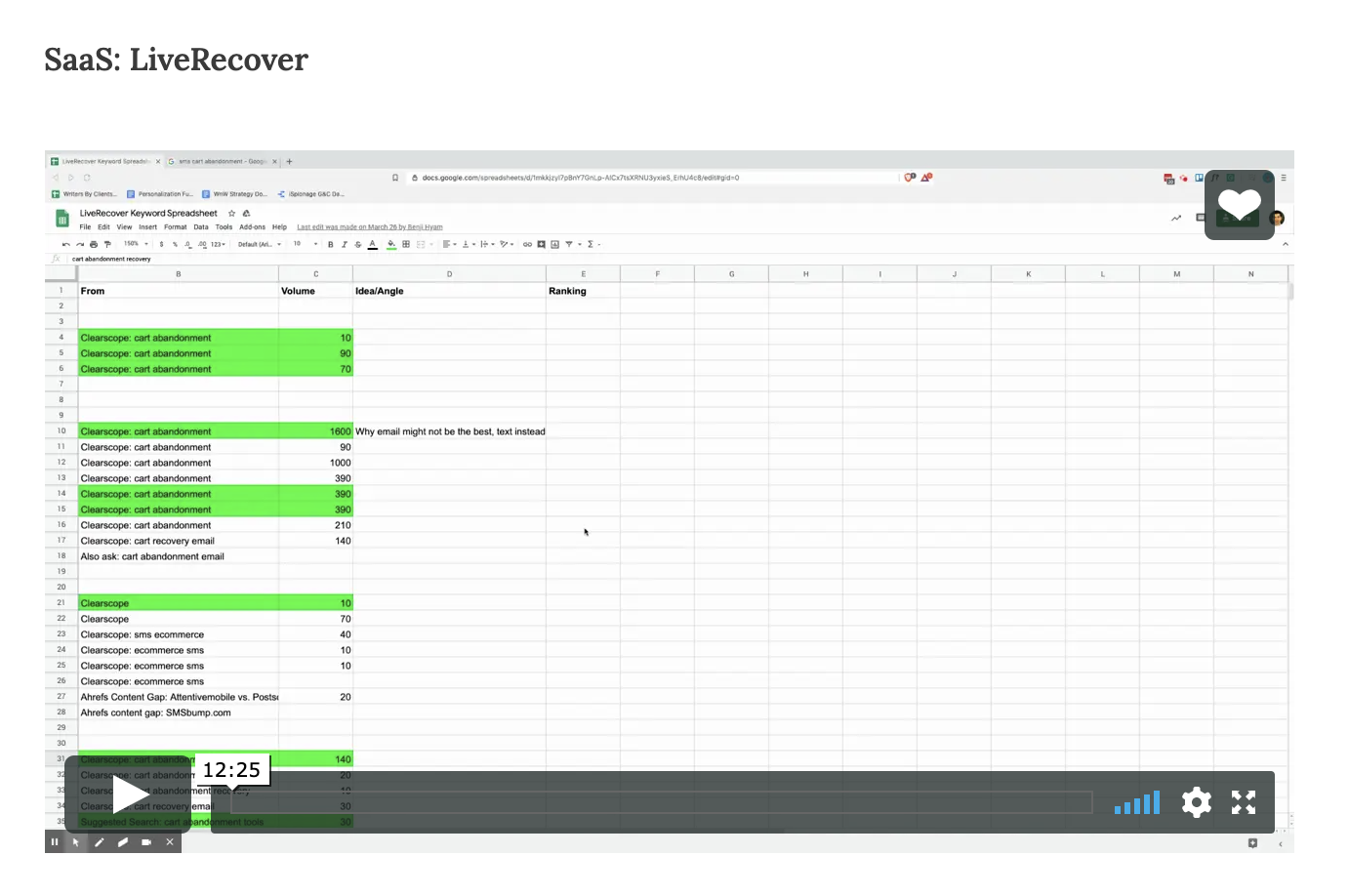
This interview method alone can dramatically improve the quality of your content.
3. A walkthrough of the questionnaires we use on every single blog post at our agency.
“Using an outline” is basic. In our agency work, we have two different questionnaires, each with a carefully crafted series of questions that lead the writer and strategist through finding the best angle for the piece.
It’s essential to our process, and in this lesson, we share it and walk through how it works and why in detail:

Incorporating this questionnaire step into your process (you can download and copy our exact questionnaires) will let you or your team shape the angle of the piece and ensure quality before it’s ever written. It has been transformative for our agency.
4. A series of lessons breaking down how to write different types of posts. Like we said above, “how to write a blog post” is different for different types of posts. So our writing module also includes a series of lessons showing detailed breakdowns of common types of blog posts we write frequently.

Each of these lessons includes incredibly detailed breakdowns of writing these different types of posts.
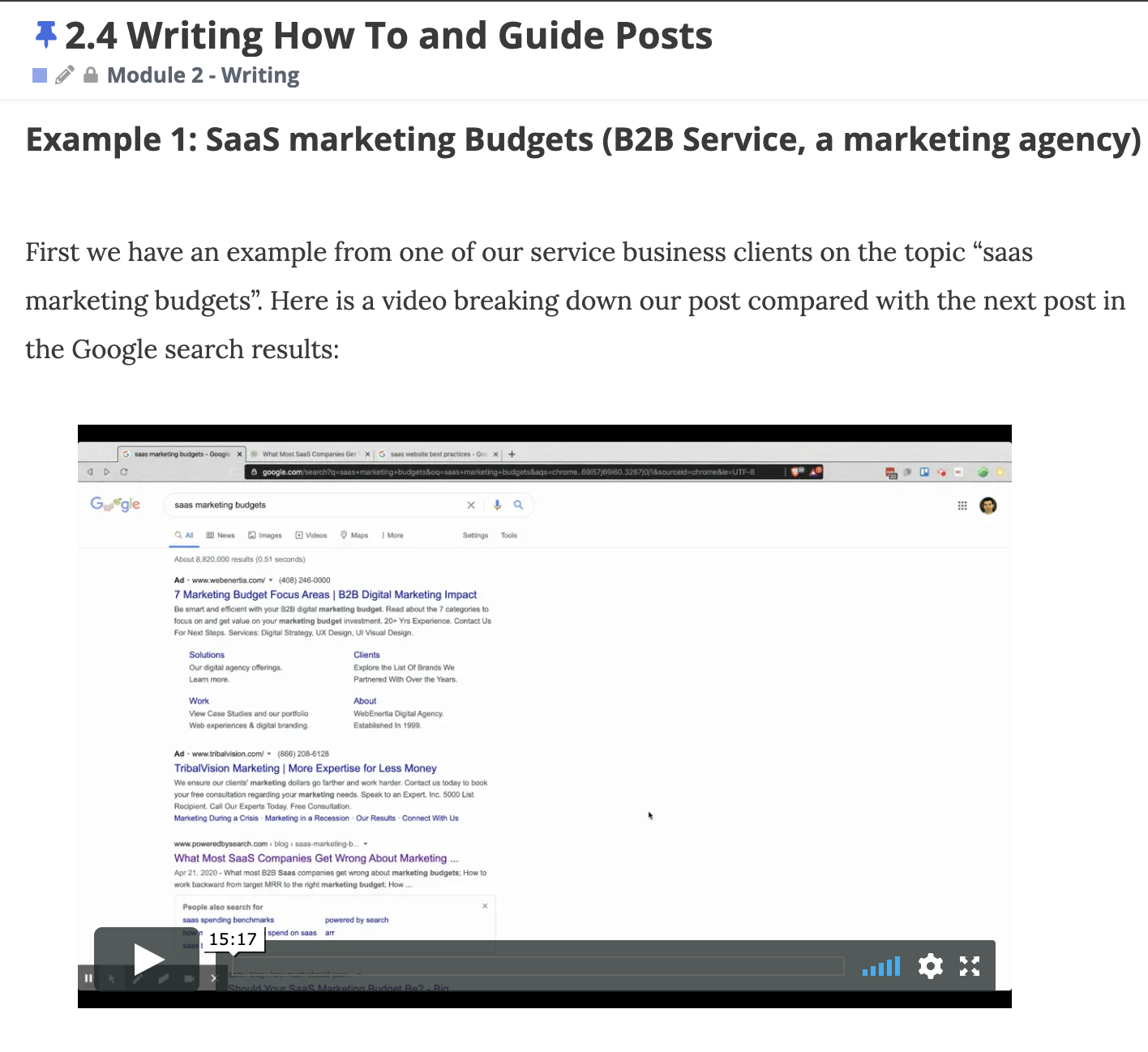

There are multiple videos like those above, each with a detailed breakdown of what makes each post good and how to write yours like it.
And, because our new course format is dynamic, we’ll be adding to these as we detect new patterns in our agency work.
Steps 1 and 2 Alone Will Get You Ahead of Competition
If you do just steps 1 and 2 above, you will be 80-90% ahead of the competition.
Step 1 (Strategy): While most people are writing on random topics and hoping it might bring in a few qualified customers, you’ll be working a proven process to only write on topics that bring in the right leads, month after month.
Step 2 (Writing): While most people are writing beginner level fluff — or outsourcing to freelancers who write beginner level fluff — you or your team will have a system for writing each type of blog article that can dive deep into topics that actually teach something to your target customers.
But in our process, we are not done, so…
Step 3: Promotion: Most Marketers Have No Method for Driving Traffic; You’ll Learn Our 2-Step Approach
It would be a waste to publish great articles, on topics that address known pain points of your target customers, and have it just sit on your blog bringing in almost no traffic.
Yet that’s what most content marketers do. “Content promotion” for them consists of maybe tweeting it out a couple times from the company account and then waiting around for Google to hopefully rank one of their pieces.
In the best case scenario, that yields a traffic curve like this:

It could take months to see any real traffic from your posts. And that’s if you get them to rank. If not, you’re sitting in the early part of that green line (zero traffic) forever. We can call this the “Hoping for SEO” curve:

Alternatively, if you have methods to promote posts immediately after publishing, you can drive traffic out of the gate. That’s a big plus, but even this method has a downside, which is that traffic falls off quickly:
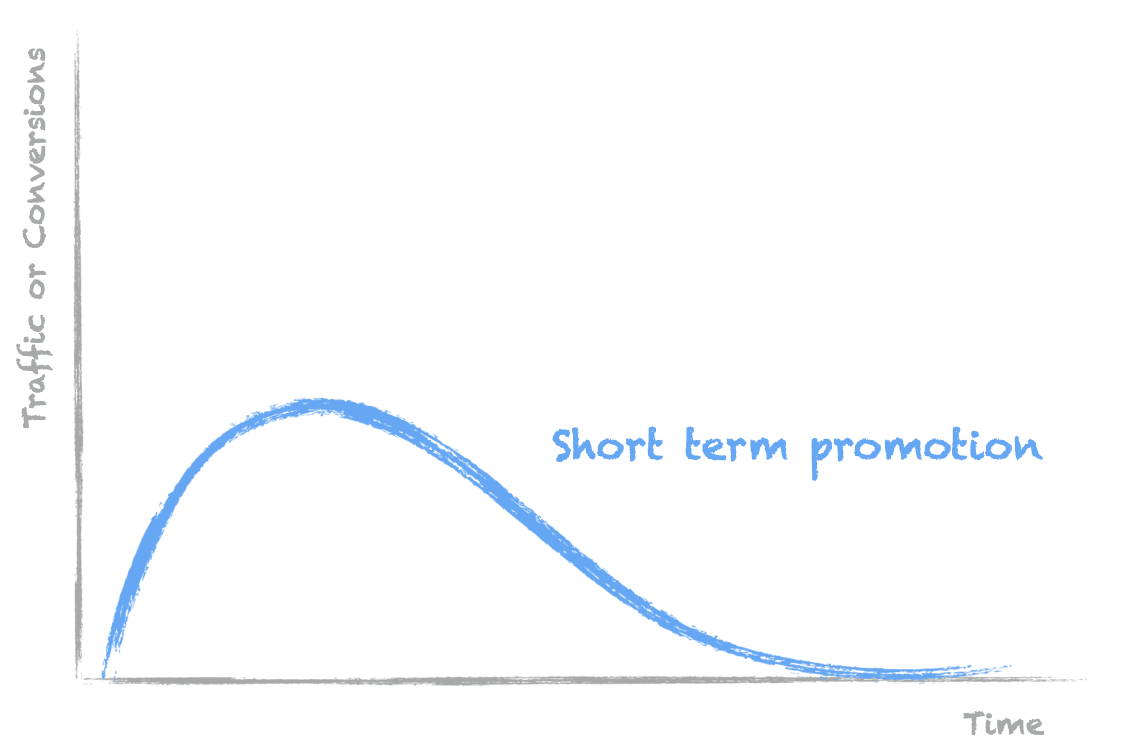
What if you had a system that could combine the two approaches, in a repeatable way?
So if you had techniques for driving short term traffic (blue line), and then you had an SEO process to get reliable rankings so that you had long-term traffic (green line), that would yield a nice traffic curve for blog posts that looks like this:

We have a process like this that we use for our clients, and that’s what has created the example traffic growth graphs we showed above.
In our course, we dedicate Module 3 to promotion.

You can immediately see how this module has more lessons than Modules 1 and 2.
Why? Because content promotion is an ever-evolving practice.
There are multiple tools you need to have in your promotion toolbelt ready to deploy in different situations. Because our course is built and presented in a community-based way, it’s a live entity, and we are constantly adding new material to this. For example, Lesson 3.7: Twitter Paid Promotion (above) is brand new as of this writing and shares recent learnings and stats from us testing paid Twitter promotion to drive leads for ourselves.
Unlike the promotion related material on our blog, because this course is case-study based, we teach these lessons as case studies, going in depth to show how we have or would execute these strategies for different businesses.
For example, for Community Content Promotion, we apply the process and find communities for Tryolabs:
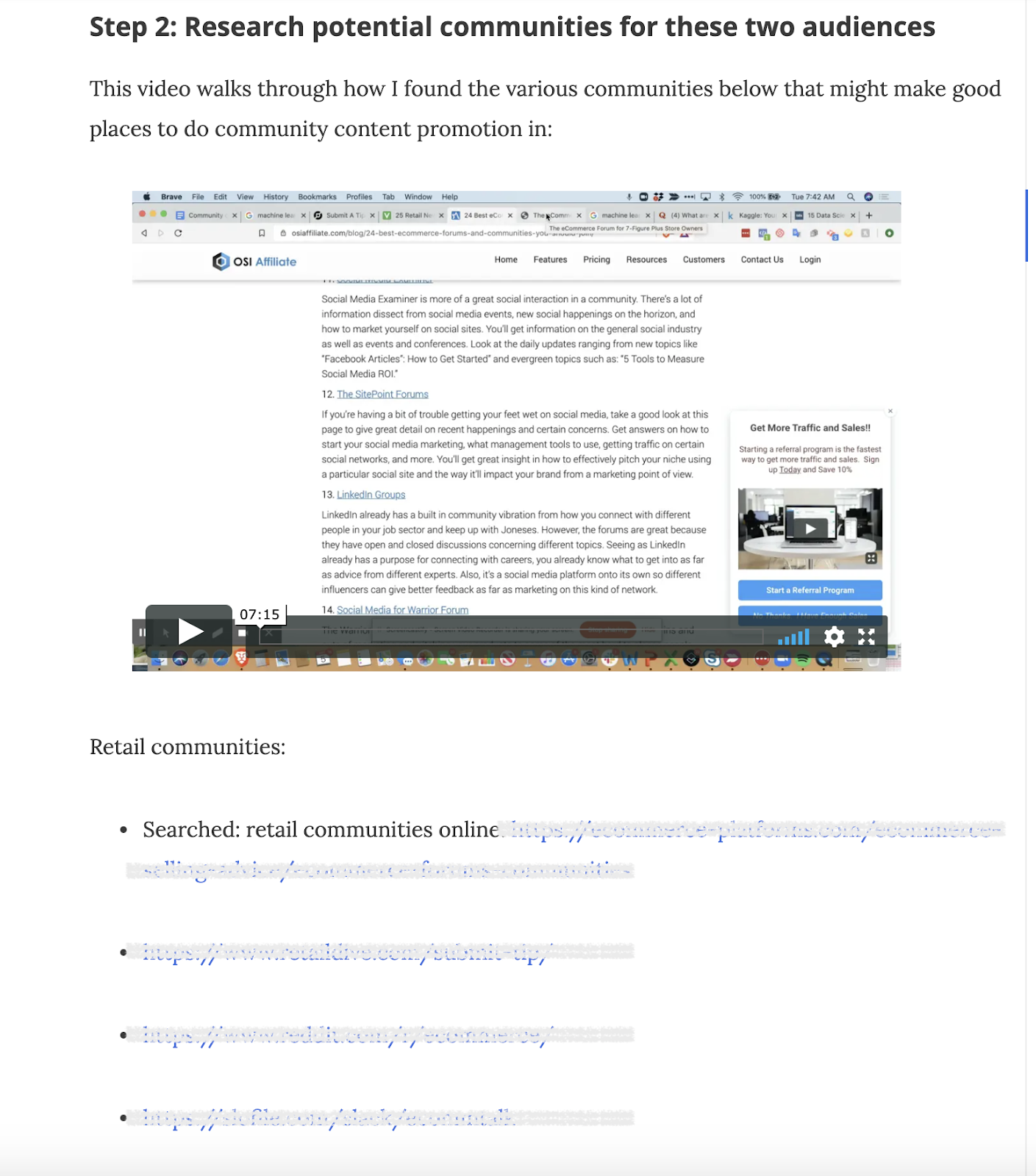
For Influencer Promotion, we do the same thing with GrowthMentor:

And for PR Promotion, we profile how we’re doing it for our client Circuit:

…Including sharing the actual spreadsheet of journalists we’re reaching out to.
These are just sample video screenshots from long lessons for each. Think of each lesson as an in-depth Grow and Convert blog post with video walkthroughs showing how to apply these lessons.
Step 4: Conversions: Most Marketers Have No Idea How Much Business Content Is Bringing In; You’ll Know This on a Piece-by-Piece Basis
Another common pain point we heard from our readers is the lack of knowing what is working and what is not.
You can’t solve the problem of “I want content to bring in actual qualified customers, not just vanity traffic” without a process to measure whether that’s happening.
We have this process built for our agency and use it daily with our clients. We can produce plots like these showing leads or signups attributable to our content:
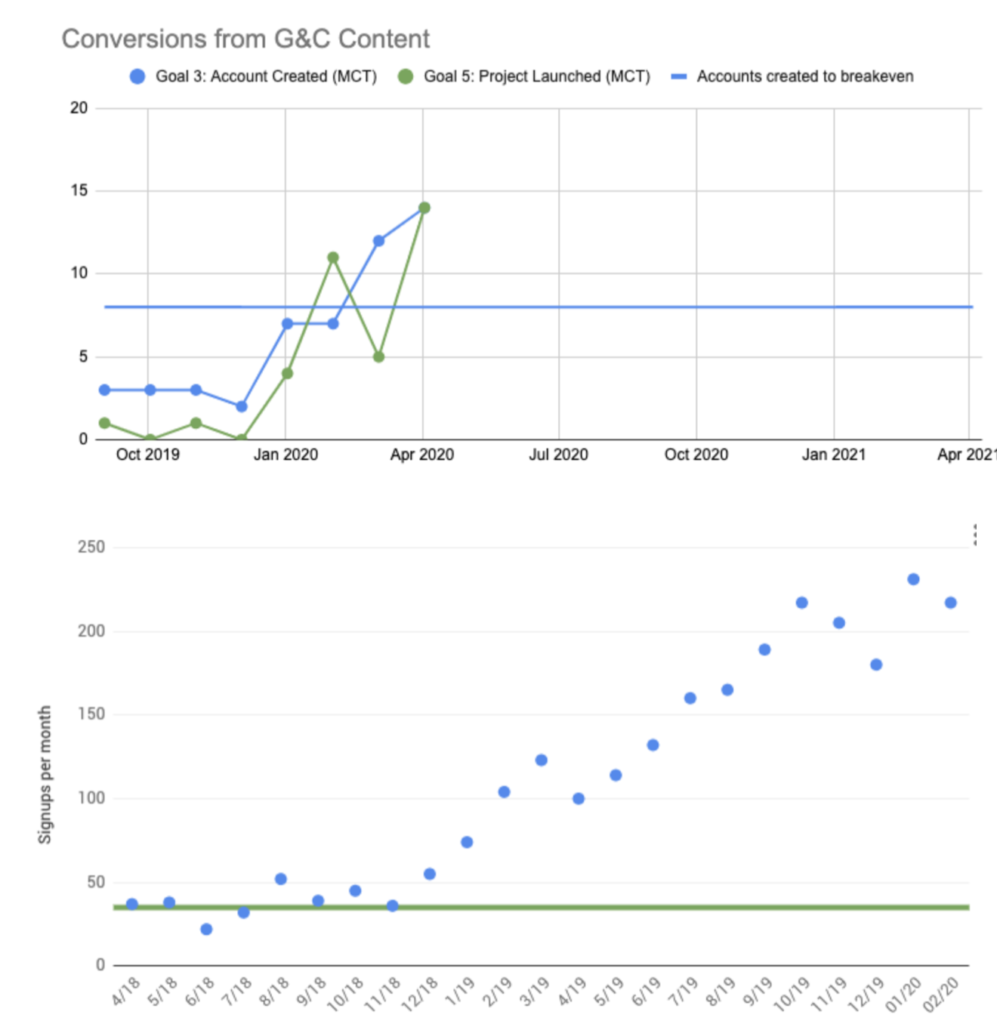
This is not hard to do. Our process just uses Google Analytics, no fancy software needed. The key for you on this topic is: You don’t need to innovate here. Save your creativity for building an awesome content strategy that pulls ready-to-convert traffic to your site (using our system taught in Module 1). Or save your creativity for turning those ideas into high-quality content pieces that impress those prospective customers once they land on your piece (using our strategies taught in Module 2).
Here, to measure conversions, just learn what we do, set up the same system, and move on.
This is what Module 4 of our course is meant for you to do.
It lets you set up a system that will measure what’s working and what’s not, then not have to waste time tinkering with that system or doubting it, so you can move on and actually do content marketing.

Simple, to the point, easy to execute — even if you’re not a coder.
In the first lesson, we lay out how measuring leads from content works, why you don’t need to stress about making “attribution” perfect, and how to set it up.
We do a screencast walkthrough of what goals you should measure for all 3 of our case studies businesses: GrowthMentor (B2C), LiveRecover (SaaS), and TryoLabs (Service).

We then walkthrough the actual setup of Google Analytics that we use for every client, which you can do yourself. We outline three different methods of measuring leads from content and what each of them mean and how they are useful:

Then, in the second lesson, we talk about what CTAs to use, where to place them, and we do an advanced discussion on the issue of “Should I first capture emails and nurture or just send them to a signup or lead form?”

We go well beyond the content on our blog and discuss multiple nuances to the question of “What CTA should I use?”:

To teach these concepts, we use examples from the three case-studied companies:

As well as our agency clients:

In the end, what you’ll be able to do after Module 4 is:
- Show yourself, your team, or your clients exactly which articles are converting and how many leads or signups each is generating
- Have a framework to decide what CTA to use (“Should I ask for an email or send them to the pricing page?”)
- Set up your conversion system once, and move on to doing content marketing.
Plus, because our course is built inside a community, you can ask us and the other members about any snags you might run into or for a second opinion on any conversion-related questions that might come up.
Let’s use that to discuss the community component in more detail…
The Community: Get Feedback, Learn From Experts, Make Connections
Content marketing is not static, and neither are our strategies. As we’ve said many times above, we are constantly learning and evolving.
So when we sat down to redo our old course, a big part of what we wanted to do is transform it from a unchanging online course to a live, growing community with discussion, comments, easy updates, and Live Q&As.
To do that, we built the entire course inside community software. That has these benefits:
- The community lets our course be organic, evolving, and easily updated, not some fixed repository
- The community lets us do live Q&As with members and outside experts such as Dave Gerhardt and Brian Dean.
- The community lets you make connections with real marketers, founders, and entrepreneurs.
The benefits are built in because there’s no separate community and course platform. It’s all in one place. Let’s look at each benefit.
Community Benefit #1: Our Course Is an Ever-Evolving Discussion, Not Some Static Repository of Videos
Most online courses are a fixed collection of videos. Updates are big elaborate things that require video crews, slide design, editing, and as a result happen once every few years… If at all.
By building our course in community software, ours is not that.
We can easily add new lessons as we work on new strategies and concepts or have new methods we’re testing.
For example, we’re currently testing Twitter ads and have some promising results, so we just added it to the course:

Or we can showcase new breakdowns of different blog post formats we’re testing, which we mark with a “(Coming Soon)” so members can comment and state what they want to see in a lesson before it comes out:

The lessons themselves are like long posts that can be easily updated when we learn new information:

See those pencils? We can easily get in and edit any lesson in seconds. And we do! For example, our agency will soon be testing new, even more specific questionnaires, and I’ll be updating that very lesson to share those with the community.
Our videos are simple screencasts, typically between 5-15 minutes, so you feel like you’re just sitting next to us watching us explain a concept on the same screen. It also means we can easily add new videos without a big production.
You can also create new topics in any module to ask for feedback, share your work, get a second opinion, or ask for a critique:

Just click “New Topic” in any module and ask a question, share your work, or ask for feedback.
For example, above, a member started a topic on how to do customer research before you have customers, and Benji and I gave our thoughts and discussed with him:
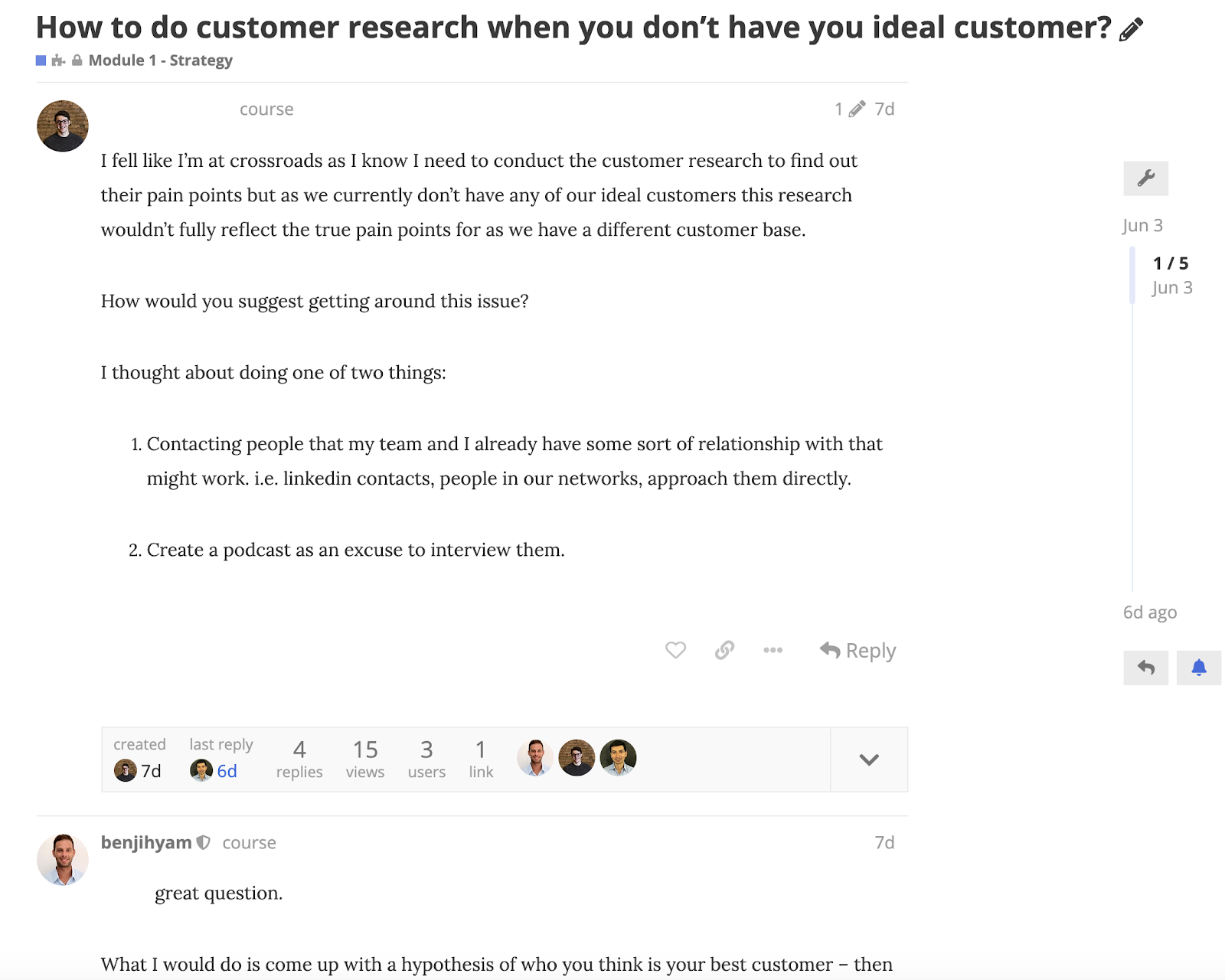
Benji gives a long answer, which we’ve cut off in the screenshot.
Community Benefit #2: Live Q&As, Case Studying Members, and Outside Experts
In addition to making the course interactive, having a members community also allows us to easily interact with members over video.
We are really excited about this aspect of the community.
Grow and Convert Q&As and Member Case Studies
First, we’ll be holding regular Live Q&As and Member Case studies, where we can dissect the content strategies, actual blog posts, and promotion strategies of real members’ businesses, live, on a Zoom screen share for everyone to participate in and learn from:
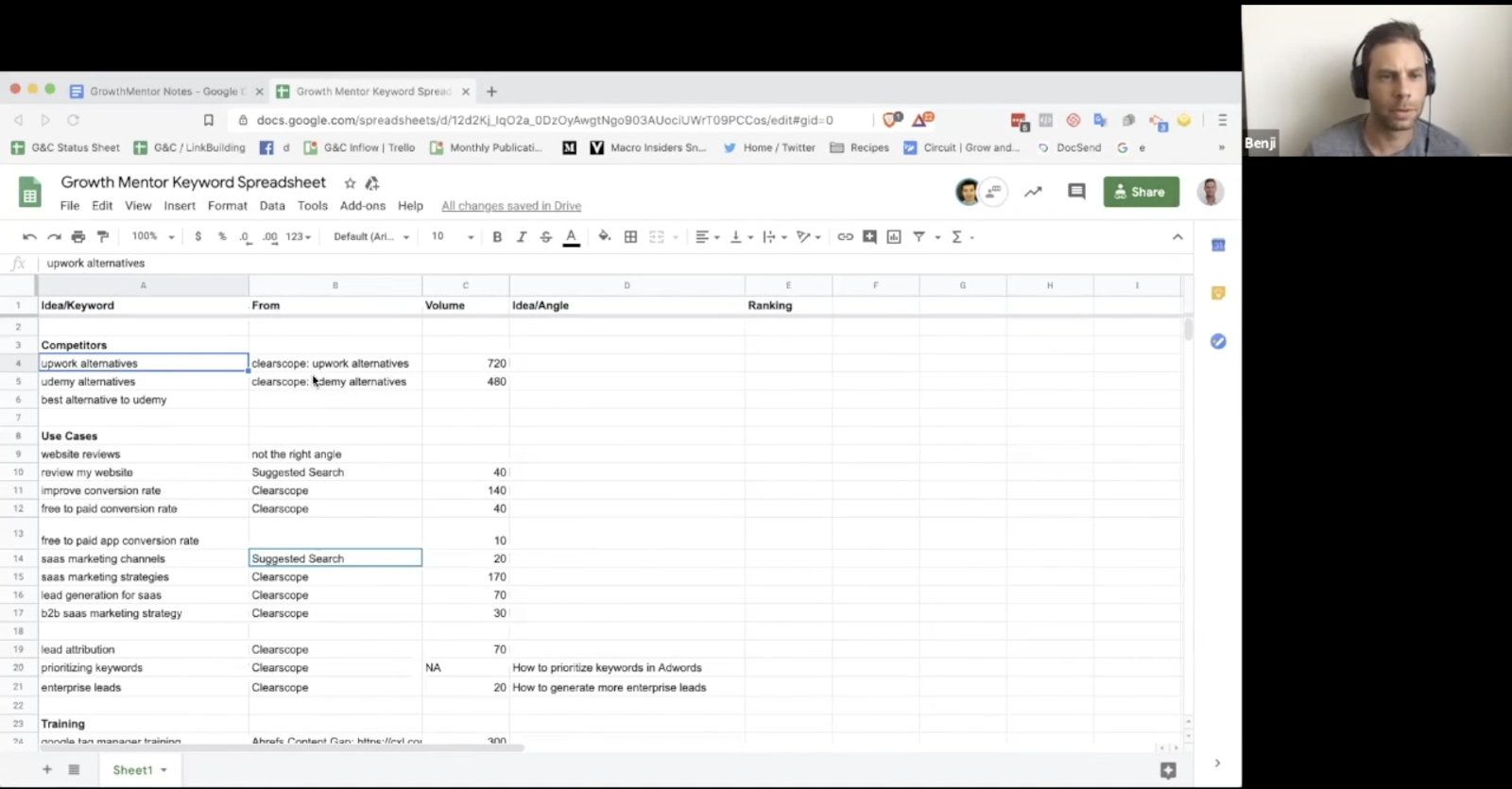
We’ll then have a topic thread in the community where members can suggest topics and post questions ahead of the calls or watch the recordings and discuss after the calls (they’ll be available forever afterwards):

Expert Interviews (like Dave Gerhardt and Brian Dean)
In addition to Q&As with us, we also are bringing in outside experts in various aspects of marketing to interview and share their strategies and techniques with us.
As of now, we’ve booked Dave Gerhardt, formerly of Drift, and Brian Dean, founder of Backlinko.
Brian Dean
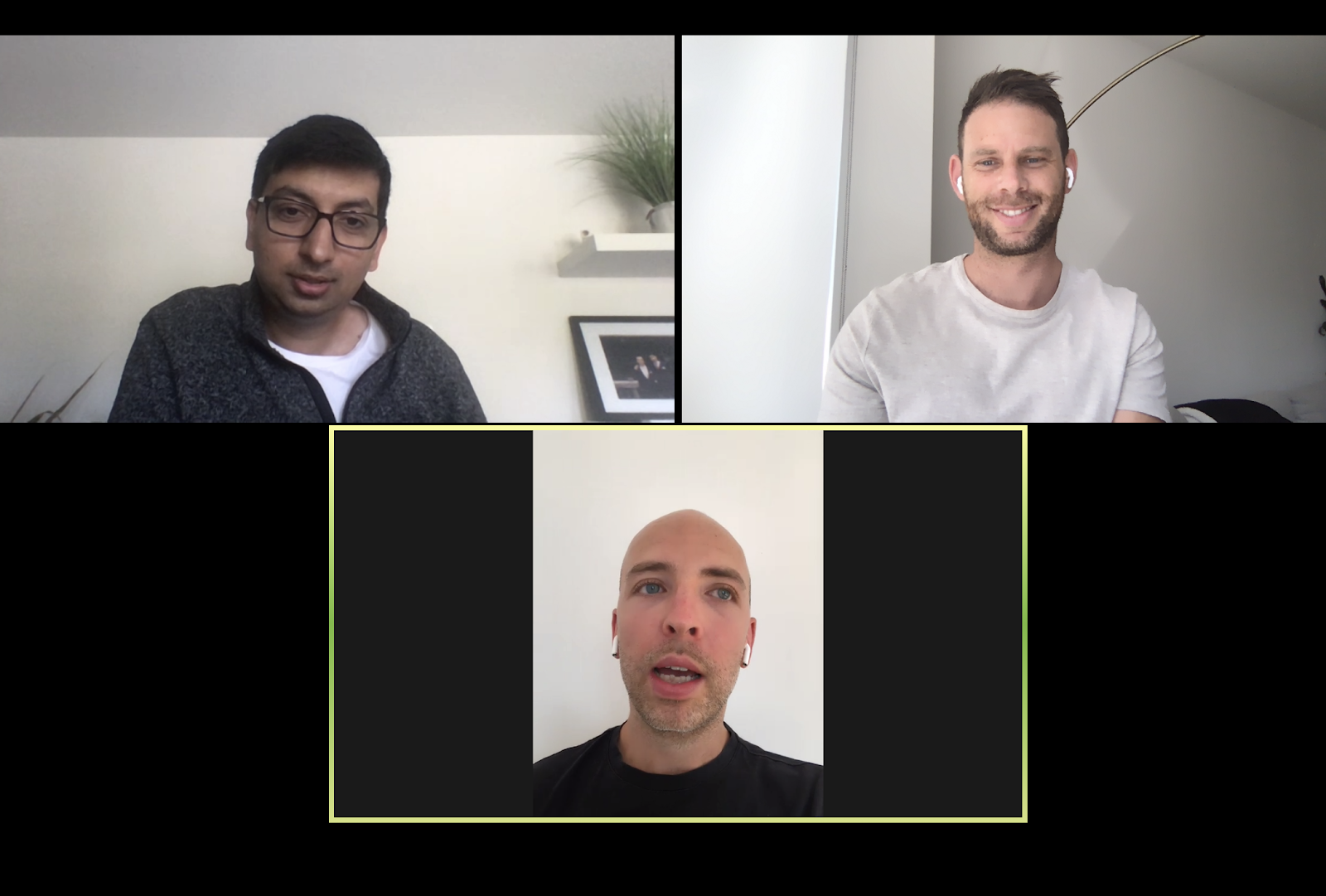
Brian Dean is the founder of Backlinko, one of the most famous SEO sites around. He is the creator of the well known “Skyscraper Technique” and ranks for some of the most competitive terms in SEO as a largely one-man operation against large companies like Moz and Ahrefs. He has analyzed tons of SEO search results to find trends that can help tell us which factors affect rankings in Google and which don’t.
We talked to him about: How he would approach SEO strategy for different business types, what he would do first and what he would postpone, and what’s working for him in SEO right now.
Dave Gerhardt
Dave Gerhardt is best known for being the VP of Marketing at Drift and is widely known as an expert in brand building, positioning, and demand gen. Drift is best known for coining the term and creating the space called “conversational marketing.” Dave is currently CMO of Privy, an email marketing tool for Shopify store owners.
We’re going to talk to him about: How a Head of Marketing thinks about the first 100 days in a new role, what channels or initiatives he focuses on first, what he postpones until later, and more.
More Experts
We’ll continue to add more outside experts to interview in spaces and topics including:
- Facebook Ads
- Google Ads
- SaaS founders and growing SaaS
- Agency founders and growing an agency.
Members will be able to make requests on who to interview.
Community Benefit #3: Make Connections with Real People
Lastly, “community” means we are all real people. We are encouraging members to use their actual headshots and names and share what they do and where they work. There is an introduction topic area just for that:


And people are making fun connections already:
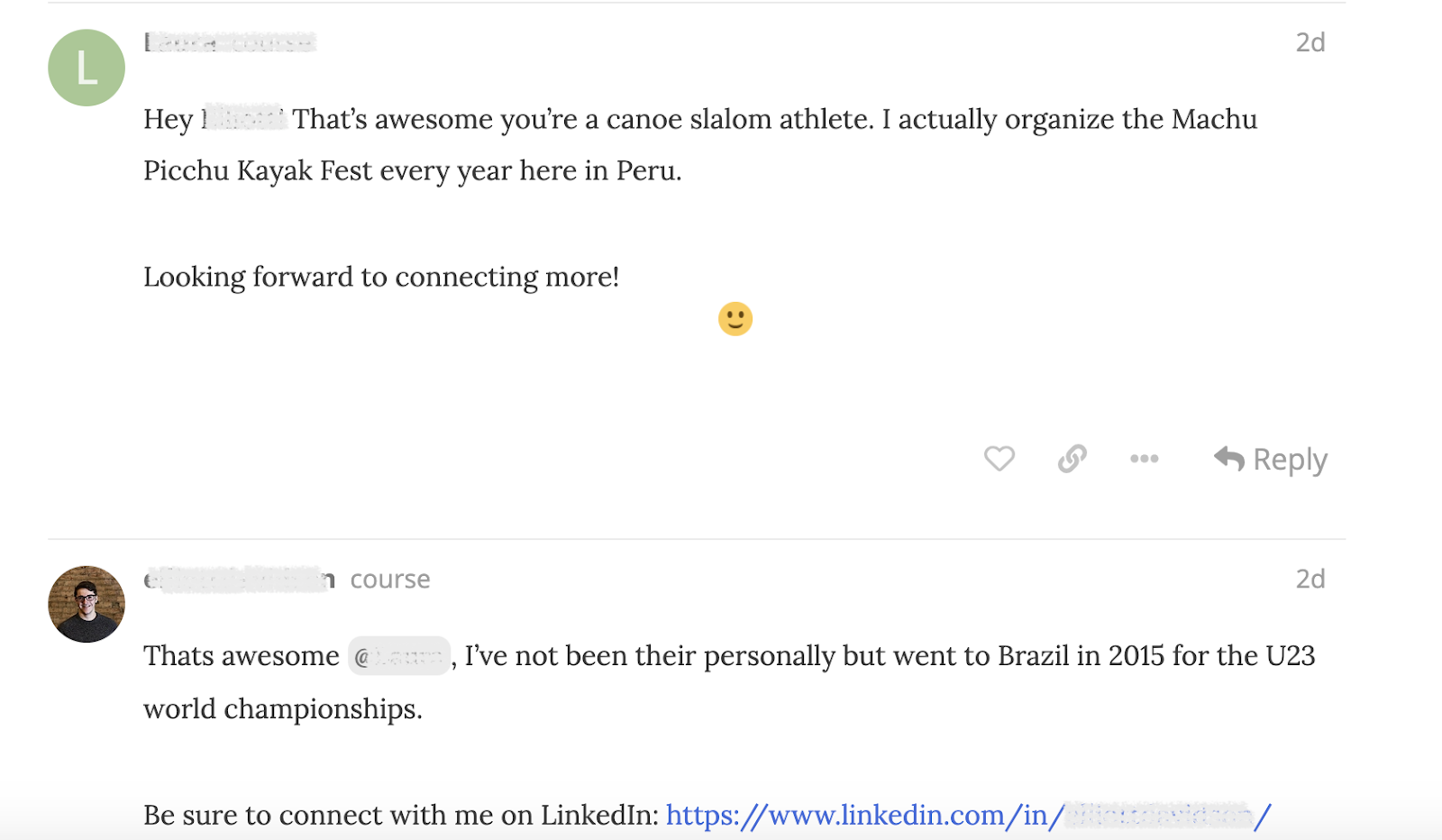
Anything hard like marketing or growing a business is best done with smart friends that can help you. Benji and I met at a marketing dinner that started from a slack community, and this entire company resulted from it, so building connections is something really important to us.
Join Now
Most communities charge a monthly subscription fee. We wanted members to have lifetime access. If you join and start to build relationships, why be forced to keep paying to continue?
Pay once and get access forever (including all future updates): $699 (For this week only — until Friday 6/19 at midnight — it’s $500). We also have a six-month payment plan for $95/month for six months.
Note if you’d like to pay in installments: You’re choosing our payment plan option, which means you’re agreeing to pay all 6 monthly installments. You’ll receive immediate access to the community after your first payment, and lifetime access after you complete your final payment. If you miss a payment, you’ll be removed from our community.
Testimonials
“The content G&C’s course is INVALUABLE. It’s seriously SO GOOD! I’ve spent over 6k on various business and marketing online courses, only to be dissatisfied with all of them. This is hands down the highest quality online course that I’ve ever taken. It has given me actionable next steps, taught me key factors on how to be successful with my content marketing, and it has really helped me formulate a plan of what to do next.”

Lisa Clifford, Owner & CEO of Autistalline, (Ecommerce)
“This is the course I wish I had when I first started out as a content marketer. It would have saved me months of wasted effort. The moment I started applying the promotional techniques that Benji & Devesh outline, I had my first post hit 6k unique views in just 3 days.”

Dave Peralta, Outreach Marketer, Hotjar
“After applying this system we’ve started getting more Android and Chatbot development leads [their ideal project types]. One of our articles got over 30k sessions (15k organic). We’ve only scratched the surface.” –

Pavel Bashmakov, Founder, Stanfy (Mobile Development Agency)
“I’ve been writing content for four years, but I was never that organized or process driven which held me back for a long time. This course finally taught me a proven system that I can use with all my clients. I’m super grateful to have found Grow & Convert.”

Tam Pham, Head of Education @ BotAcademy (Mixergy’s Chat Bot Education Site)
“I had too many ideas… but you helped me get it focused. I now have the complete foundation and framework to build a successful content marketing operation within my niche.”

Dave Lawrence, Head of Sales & Marketing, FollowupBoss (Real Estate SaaS)
“The original piece did not bring us any leads. We revamped the whole idea and went on to create an eBook and backed our claims with statistics at each level (this was after we had a discussion with you and some of our own research). Today, we have a 38% conversion rate on this e-book and have been able to start conversations with quality leads. I’m sure there’s a lot of scope for improvement.”

Taru Bhargava, Inbound Marketer, AppVirality (Mobile App SaaS)
